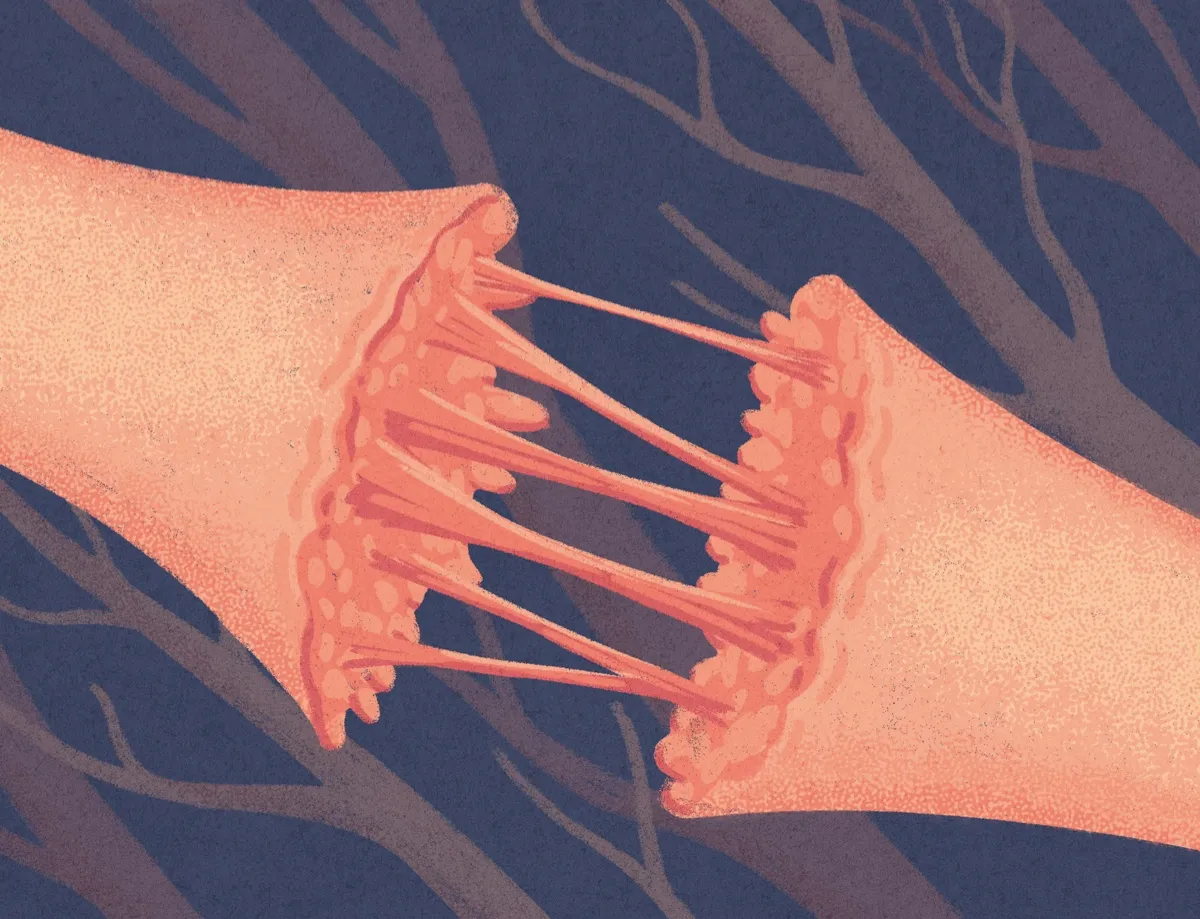What is the vagus nerve?
Your brain is connected to your body through a set of 12 crucial nerve networks that descend through your spine and branch out into your body. Of these, the vagus nerve is probably one of the most important. Its tendrils influence digestion, your heart, your reflexes and your breathing.
So you can see why scientists are so interested in what the vagus nerve does – especially when you consider how all of the above affects your mood. You could call it a superhighway between our brains and bodies.
Vagus nerve function
In contrast to the rapid ‘fight or flight’ responses that are under the control of the sympathetic arm of the nervous system, the vagus nerve is responsible for many of the slower, ‘rest and digest responses that we collectively call the parasympathetic arm. The nerve itself is actually two thick bundles of individual neurons (nerve cells) that originate in the brain and pass out to the rest of the body through left- and right-sided openings at the bottom of the skull.
Most of the individual neurons that make up the vagus nerve are sensory ones – about 100,000 on each side of the body in humans – which pass messages from the organs to the brain, and are activated by sensory input from the environment. The remainder are motor neurons, which send messages in the opposite direction, from the brain to organs, and directly control all of our muscle movements.

Why is the vagus nerve so important?
The vagus nerve is a sort of polymath of the parasympathetic nervous system, getting involved in everything from breathing, heart rate, swallowing, sneezing, digestion, appetite, immune responses and even orgasm.
The vagus nerve’s wide-ranging skill set comes from having a diverse array of neuron cell types at its disposal. These allow the nerve to pick up different types of sensory signals from different organs. Some, for instance, sense chemical signals like oxygen levels in the blood or the secretions of bacteria in the intestine, while others sense mechanical signals like stretching of the blood vessels and gut.
Therefore, the neurons in the vagus nerve mostly give the brain information about what is going on in the rest of the body. The brain interprets this information and acts upon it to help maintain the internal status quo. But there are also important functions associated with the less numerous neurons that send signals the opposite way, including in communications between the brain and gut, and in select muscles in the mouth and throat that are responsible for speech and the gag reflex.
The functions of the vagus nerve are so numerous and varied that it’s very likely there are roles that we have yet to uncover. We do know, however, how we can tap into it. Doctors sometimes prescribe ‘valsalva manoeuvres’ to activate the vagus nerve and slow a fast-beating heart or calm heart palpitations. These might involve activities like coughing, straining like you’re on the toilet or, perhaps most bizarrely, doing a handstand.
Read more about stress:
- Dogs really can tell when we're stressed, by smelling it on our sweat and breath
- How do I stop turning into a bundle of nerves when I'm taking exams?
- Gardening just twice a week improves wellbeing and relieves stress
The long and winding nerve
The word, ‘vagus’ means ‘wandering’ in Latin, and the vagus nerve truly is. The nerve bundles reach as far as the base of the spine and colon, branching off to the vital organs, including the heart, lungs, liver and gut, along the way.
As the longest cranial nerve in the body, it’s the main component of the parasympathetic nervous system, which controls automatic bodily functions such as digestion, when the body is at rest. Historically, the vagus nerve was known as the pneumogastric nerve, because it supplies both the lungs and stomach with nerves.
How is the vagus nerve connected to our wellbeing?
When we’re in a high-stress situation, our sympathetic nervous system’s fight or flight responses kick in, enabling us to deal with it quickly. The parasympathetic nervous system, meanwhile, comes into play more slowly to promote a more restful state, so it is crucial for helping us relax and calm down after experiencing stress.
With help from the vagus nerve, our brain recognises that, for example, our breathing and heart rate have accelerated and puts the brakes on. While the sympathetic and parasympathetic arms aren’t always in sync – they can operate separately or in a more coordinated way – in theory, there is a balance to their activities that can be upset in certain circumstances. These include bowel disorders and mental health conditions. Persistent stress is thought to be a cause of sympathetic overdrive and researchers say they can detect this in people with depression, for example.
The vagus nerve and the heart
One key metric that is often used is heart rate variability – the variation in the gaps between consecutive heartbeats. A healthy heartbeat is slightly more chaotic in its rhythm, so low variation is said to be associated with a jacked-up sympathetic system, where the body is in constant fight or flight mode, with the vagus nerve and parasympathetic response struggling to keep up.
Despite its widespread use, however, there are still some questions about how useful heart rate variability can be as an indicator of balance between the parasympathetic and sympathetic systems. Although heart rate monitors can give us this information, we shouldn’t obsess about the numbers.

What happens if the vagus nerve is damaged?
In the past, stomach ulcers were often treated by cutting the fibres of the vagus nerve below the rib cage. The thinking was that the vagus nerve plays a central role in producing the stomach acid that causes the sores. With modern drugs, the need for this type of surgery has decreased, but it demonstrates what can happen when a nerve with so many branches is compromised.
Indeed, ‘vagatomies’ cut off the vagal nerve supply to the stomach, pancreas, small intestine and part of the colon, meaning that without further surgery to the gut, the patient may be unable to pass solid waste. People with gastroparesis suffer from a similar problem, but in this case, the symptoms are usually due to vagus nerve damage caused by diabetes, drugs or infection.
However, when the vagus nerve is damaged higher up, the effects can be completely different. The chickenpox virus, for example, attacks the nervous system and though rare, it has been known for the virus to cause vagus nerve lesions that result in a patient losing their ability to swallow – they may also get a headache and an inflamed ear. Early data collected by Spanish researchers also suggests that some of the symptoms of long COVID may be related to vagus nerve damage, including breathing, voice and bowel issues.
Do I need to get myself a vagus nerve stimulator?
The evidence we have so far suggests devices for vagus nerve stimulation are safe. However, researchers are still concerned about the increase in at-home use of nerve stimulators, which may come with risks that we’re not yet aware of.
Those who prefer mindfulness to being hooked up to machines are turning to activities such as yoga, meditation, hypnotherapy and deep breathing, all of which are thought to boost the functioning of the parasympathetic nervous system and vagus nerve. There is also evidence to suggest that cold water swimming or bathing, or even just splashing your face with cold water, can stimulate the vagus nerve and activate the parasympathetic system.
Of course, buying a cheap device to attach to your ear, or signing up to take part in yoga retreat, may seem like an appealing fix when you’re not feeling quite right, but it’s always best to get serious health complaints checked by a doctor.
Read more about ways to relax:
- Does massage work?
- Naps: A user's guide
- Cold water swimming: Why an icy dip is good for your mental and physical health
What is vagus nerve stimulation?
The concept of vagus nerve stimulation goes back as far as the late 19th century, when the neurologist James Leonard Corning developed an electrical stimulator to treat epileptic patients. Although it was discarded as a treatment back then, over 100,000 people have now had vagus nerve stimulation – by implant in the chest or, less often, brain – to treat epilepsy when the drugs they’ve tried haven’t worked.
Some people are able to get as much as a 75 per cent reduction in their seizures with an implant, with multiple studies showing the benefits increase the longer the implant has been installed. An implantable device made by the US medical technology companyCyberonics is also approved for severe depression and headaches.
Nerve stimulation doesn’t have to mean surgery, though. It’s possible to access the vagus nerve through its branches in the ear and neck, for example, using devices similar to the inexpensive TENS machines more commonly used for quelling labour pain. Ear clips are widely sold as TENS attachments, while companies like Nurosym make stylish neuromodulators targeted at people who want to try the approach for anxiety, depression or fatigue.
Scientific research on vagus nerve stimulation is exploding currently, with trials covering burns, obesity, high blood pressure, rheumatoid arthritis, Alzheimer’s, tinnitus…the list goes on. Due to the close connection between the vagus nerve and gut function, it’s also touted as a potential treatment for common bowel disorders like IBS. Although, as with other conditions,the process of gathering evidence from trials to support its use will take time.

Five facts you need to know about the vagus nerve
- It’s the longest cranial nerve, running from the brain to the large intestine, and sends signals in both directions via neurotransmitters and gut hormones.
- The fibres of the vagus nerve contain 200,000 sensory nerve cells. Our ears are the only place where sensory vagus nerve fibres reach the surface of our bodies.
- A vagus nerve ‘bypass’ that carries impulses directly between the uterus and brain is thought to allow women with spinal cord injuries to have orgasms.
- Vagus nerve stimulation affects the gamma-aminobutyric acid neurotransmitter associated with ADHD, leading scientists to propose it as a potential treatment.
- The scientific name for fainting is vasovagal syncope, which occurs when the vagus nerve is overstimulated, causing a sudden drop in heart rate and blood pressure.
Read more about the human body:
- Tinnitus: Everything you need to know
- The mystery of migraines
- Why it's time we changed our relationship with fat
To submit your questions email us at questions@sciencefocus.com (don't forget to include your name and location)